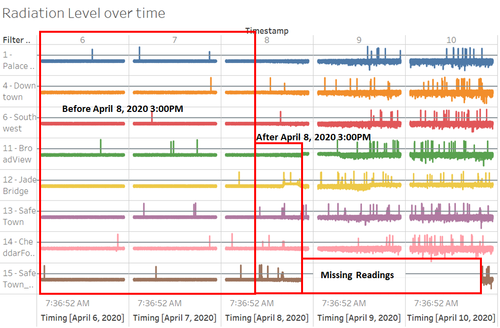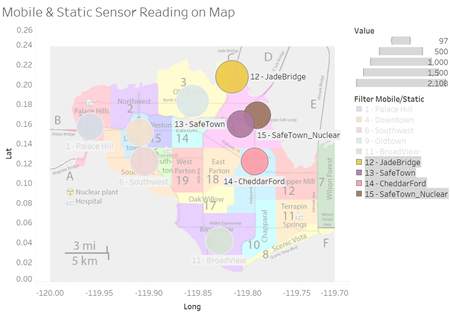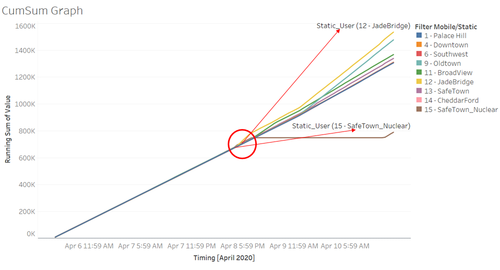Difference between revisions of "IS428 AY2019-20T1 Assign Christine Anomalies Observation"
| Line 27: | Line 27: | ||
==<div><font color=#100c08 face="Century Gothic"><b>Q1. Visualize radiation measurements over time from both static and mobile sensors to identify areas where radiation over background is detected. Characterize changes over time.</b></font></div>== | ==<div><font color=#100c08 face="Century Gothic"><b>Q1. Visualize radiation measurements over time from both static and mobile sensors to identify areas where radiation over background is detected. Characterize changes over time.</b></font></div>== | ||
| − | '''Static Sensor | + | <strong>STATIC SENSOR READINGS</strong></br> |
| + | <div><center><ul> | ||
| + | <li style="display: inline-block;" id="F1.1"> [[File:christine.2016_figure_1.1_RadiationOverTime.png|thumb|none|500px|''Figure 1.1 - Static Sensor’s readings over time period'']] </li> | ||
| + | </ul></center></div> | ||
| + | In terms of radiation level, healthy reading level was set at 25cpm, when any sensor readings that exceed this healthy level; attention need to be given to the respective sensor. Based on the readings, before '''8 April 2020 04:00PM''', radiation level shows minor fluctuation (relatively stable in terms of changes in reading); however, after '''8 April 2020 04:00PM''', there are significant spikes of radiation readings spotted across all sensors but especially sensor '''12-JadeBridge, 13-SafeTown, 14-CheddarFord, and 15-SafeTown_Nuclear''' have the noisiest spikes among other sensors on this day. In addition, notable that after '''8 April 2020 10:06:25PM''', sensor 15-SafeTown_Nuclear has some missing readings but the readings start to appear again on '''10 April 2020 8:47PM'''. Some possible reason could be due to location sensor 15-SafeTown_Nuclear that located near to the power plant. | ||
| + | |||
| + | <div><center><ul> | ||
| + | <li style="display: inline-block;" id="F1.2"> [[File:christine.2016_figure_1.2_StaticSensorReadingOnMap.png|thumb|none|450px|''Figure 1.2 - Static Sensor readings at location on map'']] </li> | ||
| + | <li style="display: inline-block;" id="F1.3"> [[File:christine.2016_figure_1.3_CumSumStaticSensor.png|thumb|none|500px|''Figure 1.3 - Cumulative sum of static sensor’s readings'']] </li> | ||
| + | </ul></center></div> | ||
| + | </br> | ||
| + | Another interesting finding shown through map which sensors with noisiest spikes of radiation readings '''12-JadeBridge, 13-SafeTown, 14-CheddarFord, and 15-SafeTown_Nuclear''' are located nearest to the power plant especially sensor '''13-SafeTown and 15-SafeTown_Nuclear''' located in the region of Safe Town – location of Always Safe Nuclear power plant. This explain the reason behind the noisy spikes could be because of the location. Additionally, from Cumulative Sum of radiation readings, we can clearly identify the first few sensors that show abnormal spikes in radiation readings are sensor '''12-JadeBridge and 15-Safe Town_Nuclear'''. | ||
<br/> | <br/> | ||
Revision as of 00:41, 11 October 2019
Contents
- 1 Q1. Visualize radiation measurements over time from both static and mobile sensors to identify areas where radiation over background is detected. Characterize changes over time.
- 2 Q2. Use visual analytics to represent and analyze uncertainty in the measurement of radiation across the city.
- 2.1 Q2a. Compare uncertainty of the static sensors to the mobile sensors. What anomalies can you see? Are there sensors that are too uncertain to trust?
- 2.2 Q2b. Which regions of the city have greater uncertainty of radiation measurement? Use visual analytics to explain your rationale.
- 2.3 Q2c. What effects do you see in the sensor readings after the earthquake and other major events? What effect do these events have on uncertainty?
- 3 Q3. Given the uncertainty you observed in question 2, are the radiation measurements reliable enough to locate areas of concern?
- 3.1 Q3a. Highlight potential locations of contamination, including the locations of contaminated cars. Should St. Himark officials be worried about contaminated cars moving around the city?
- 3.2 Q3b. Estimate how many cars may have been contaminated when coolant leaked from the Always Safe plant. Use visual analysis of radiation measurements to determine if any have left the area.
- 3.3 Q3c. Indicated where you would deploy more sensors to improve radiation monitoring in the city. Would you recommend more static sensors or more mobile sensors or both? Use your visualization of radiation measurement uncertainty to justify your recommendation.
- 4 Q4. Summarize the state of radiation measurements at the end of the available period. Use your novel visualizations and analysis approaches to suggest a course of action for the city. Use visual analytics to compare the static sensor network to the mobile sensor network. What are the strengths and weaknesses of each approach? How do they support each other?
- 5 Q5. The data for this challenge can be analyzed either as a static collection or as a dynamic stream of data, as it would occur in a real emergency. Describe how you analyzed the data - as a static collection or a stream. How do you think this choice affected your analysis?
Q1. Visualize radiation measurements over time from both static and mobile sensors to identify areas where radiation over background is detected. Characterize changes over time.
STATIC SENSOR READINGS
In terms of radiation level, healthy reading level was set at 25cpm, when any sensor readings that exceed this healthy level; attention need to be given to the respective sensor. Based on the readings, before 8 April 2020 04:00PM, radiation level shows minor fluctuation (relatively stable in terms of changes in reading); however, after 8 April 2020 04:00PM, there are significant spikes of radiation readings spotted across all sensors but especially sensor 12-JadeBridge, 13-SafeTown, 14-CheddarFord, and 15-SafeTown_Nuclear have the noisiest spikes among other sensors on this day. In addition, notable that after 8 April 2020 10:06:25PM, sensor 15-SafeTown_Nuclear has some missing readings but the readings start to appear again on 10 April 2020 8:47PM. Some possible reason could be due to location sensor 15-SafeTown_Nuclear that located near to the power plant.
Another interesting finding shown through map which sensors with noisiest spikes of radiation readings 12-JadeBridge, 13-SafeTown, 14-CheddarFord, and 15-SafeTown_Nuclear are located nearest to the power plant especially sensor 13-SafeTown and 15-SafeTown_Nuclear located in the region of Safe Town – location of Always Safe Nuclear power plant. This explain the reason behind the noisy spikes could be because of the location. Additionally, from Cumulative Sum of radiation readings, we can clearly identify the first few sensors that show abnormal spikes in radiation readings are sensor 12-JadeBridge and 15-Safe Town_Nuclear.
Q2. Use visual analytics to represent and analyze uncertainty in the measurement of radiation across the city.
Q2a. Compare uncertainty of the static sensors to the mobile sensors. What anomalies can you see? Are there sensors that are too uncertain to trust?
Q2b. Which regions of the city have greater uncertainty of radiation measurement? Use visual analytics to explain your rationale.
Q2c. What effects do you see in the sensor readings after the earthquake and other major events? What effect do these events have on uncertainty?
Q3. Given the uncertainty you observed in question 2, are the radiation measurements reliable enough to locate areas of concern?
Q3a. Highlight potential locations of contamination, including the locations of contaminated cars. Should St. Himark officials be worried about contaminated cars moving around the city?
Q3b. Estimate how many cars may have been contaminated when coolant leaked from the Always Safe plant. Use visual analysis of radiation measurements to determine if any have left the area.
Q3c. Indicated where you would deploy more sensors to improve radiation monitoring in the city. Would you recommend more static sensors or more mobile sensors or both? Use your visualization of radiation measurement uncertainty to justify your recommendation.
Q4. Summarize the state of radiation measurements at the end of the available period. Use your novel visualizations and analysis approaches to suggest a course of action for the city. Use visual analytics to compare the static sensor network to the mobile sensor network. What are the strengths and weaknesses of each approach? How do they support each other?
Q5. The data for this challenge can be analyzed either as a static collection or as a dynamic stream of data, as it would occur in a real emergency. Describe how you analyzed the data - as a static collection or a stream. How do you think this choice affected your analysis?


